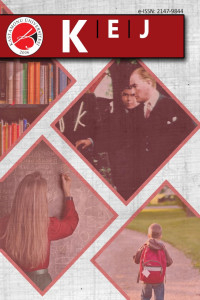Abstract
References
- Wilhelm, J., Jackson, C., Sullivan, A., & Wilhelm, R. (2013). Examining differences between preteen groups spatial-scientific understandings: A quasi-experimental study. Journal of Educational Research, 106(5), 337–351. https://doi.org/10.1080/00220671.2012.753858
- Yin, R. K. (2003). Case study research: Design and methods (3rd ed.). Sage Publications.
Shedding Light on Pre-Service Science Teachers' Instructional Preferences and Hurdles in Teaching Phases of the Moon
Abstract
Purpose: This study aimed to investigate the instructional methods employed by pre-service science teachers and explore the difficulties they encountered while teaching the concept of moon phases.
Design/Methodology/Approach: The present study employed a qualitative research approach using case study methodology to explore the experiences of eight pre-service science teachers. Data were collected through observation of instruction, examination of lesson plans, and semi-structured interviews to gain insights into their instructional practices and challenges. Specifically, the study aimed to understand the difficulties encountered by these pre-service teachers when teaching the phases of the moon. This approach allowed for a rich and in-depth understanding of the complex nature of teaching science to pre-service teachers.
Findings: Analysis revealed that pre-service science teachers predominantly favored physical models and simulations for teaching moon phases. However, the study also identified challenges faced by these teachers in implementing topic-specific teaching strategies.
Highlights: These issues highlight the importance of equipping pre-service science teachers with adequate preparation and resources to effectively teach the phases of the moon. Addressing these concerns may involve providing accurate models, instructing on proper terminology, and offering activities that foster spatial awareness to enhance their understanding and teaching abilities.
References
- Wilhelm, J., Jackson, C., Sullivan, A., & Wilhelm, R. (2013). Examining differences between preteen groups spatial-scientific understandings: A quasi-experimental study. Journal of Educational Research, 106(5), 337–351. https://doi.org/10.1080/00220671.2012.753858
- Yin, R. K. (2003). Case study research: Design and methods (3rd ed.). Sage Publications.
Details
| Primary Language | English |
|---|---|
| Subjects | Science Education |
| Journal Section | Research Article |
| Authors | |
| Publication Date | April 29, 2024 |
| Acceptance Date | March 12, 2024 |
| Published in Issue | Year 2024 Volume: 32 Issue: 2 |


